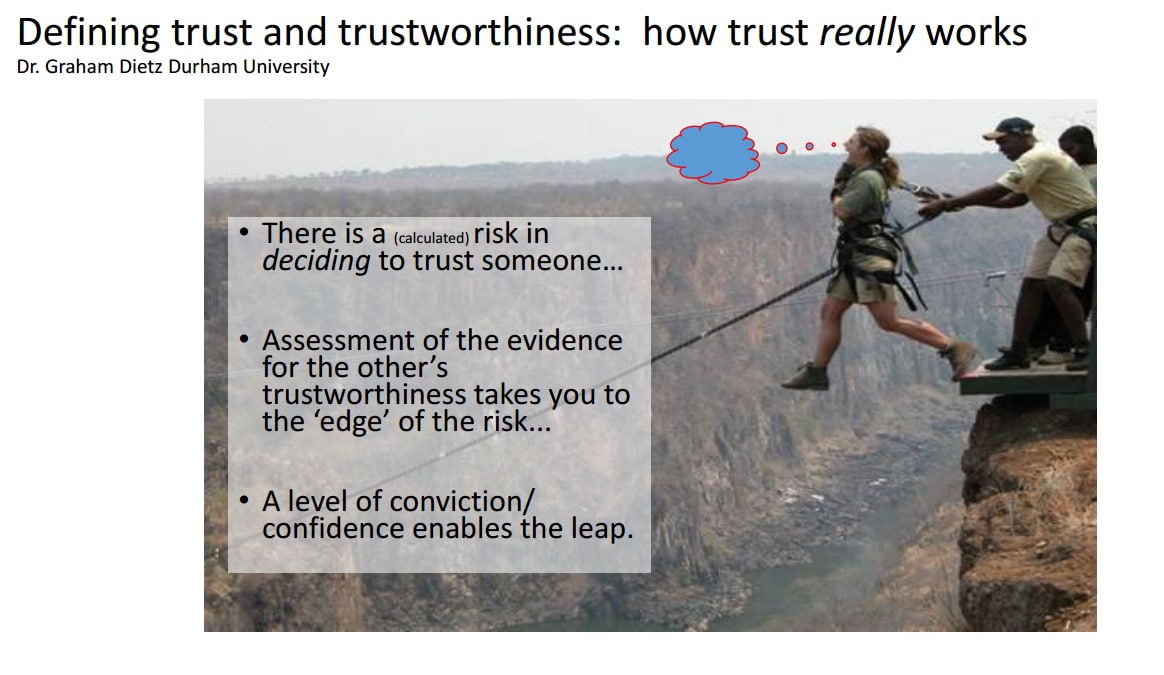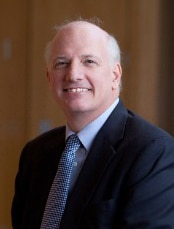Trust
 Ethics and trust are inextricably linked. We are interested in ethics in large part because we are concerned, even obsessed, with the question of who we can trust is a world where there is risk and uncertainty. In our relationships, we humans are much more concerned about assessing trustworthiness of others than we are in trying to figure out how ethical they are. So what is trust and what is trustworthiness? The mountain image on right depicts our human situation of uncertainty.
Ethics and trust are inextricably linked. We are interested in ethics in large part because we are concerned, even obsessed, with the question of who we can trust is a world where there is risk and uncertainty. In our relationships, we humans are much more concerned about assessing trustworthiness of others than we are in trying to figure out how ethical they are. So what is trust and what is trustworthiness? The mountain image on right depicts our human situation of uncertainty.
Our lives are embedded in human networks where we need to assess trust (see Trust Choice Schematic). The Decision to Trust Model (DTM Model) was developed (see below HBR 2006 article or Jossey Bass 2012 book) to help us make better decisions about discerning trustworthiness and even repairing trust.
Trustworthiness relates directly to ethics on two specific dimensions: integrity and benevolence. In brief: ‘‘A trustworthy party is one that will not unfairly exploit the vulnerabilities of the other party in the relationship.’’ (see Banerjee, Bowie and Pavone An Ethical Analysis of the Trust Relationship page 308 in Bachmann and Zaheer eds. Handbook of Trust Research in book chapter below).
Trust relationships exist at many levels: between two people, among members of a team, between teams, within an organization, between workers and management and even within an entire system, like the financial system or the air traffic control system. The further removed individuals are from the locus of the relationship, it becomes more complicated to assess trustworthiness. For example, how do you judge the trustworthiness of a bank or a financial system that is saving your money? We would like use a combination of personal and impersonal cues. For example, if we were making a trust judgment about a doctor for surgery, we might assess not only the doctor but also what hospital he or she operates in.
The ideas on this page will cover various aspects of trust but will concentrate on the trustworthiness of organizational systems and institutions, which are central to a well functioning society.
 |
 |
 |
 |
 |
 |
|
“The toughest thing about the power of trust is that it’s very difficult to build and very easy to destroy.” |
1. How do you create organizations or cultures centered on trust? How can leadership enhance or erode trust?
- See this article in MIT Sloan Management Review on Designing Trustworthy Organizations as well as this piece on How to Become a Trustworthy Leader.
2. How do people establish trust?
See the late Graham Dietz from Durham University in the UK describing:
How do biases, perceptions and habits interact with organizational efforts to create a trusting culture?
Since the degree to which we offer trust is based on our perceptions of the trustworthiness of another, all of our cognitive biases and our emotions affect whom and when we trust.
For example, research in social identity theory shows that we are more apt to trust people who we think are similar to us. This is why the decision making research page is so helpful in understanding the decision to trust. There is a need to make trust decisions more slowly and more deliberately so that we are less subject to the fast thinking part of our brains and emotions that can sometimes fool us.
Research also shows that our perceptions of what it means to be trustworthy are socially constructed and vary across cultures (see excellent review by Ferrin and Gillespie Trust Differences Across National Cultures in Saunder, Skinner, Dietz, Gillespie and Lewicki Eds. Organizational Trust: A Cultural Perspective).
3. What is the business case for trust?
There is a tremendous case to be made that “trust pays.” See this presentation that summarizes the empirical research on the link between various aspects of performance and trust. The case is so compelling that it begs the question: if trust is so valuable, why don’t we have more companies chasing this holy grail? One answer is that it is very hard to do and takes great leadership and consistent focus on building the elements of a trustworthy organization.
| Research Entry Points | |
|---|---|
 |
How to Inspire TrustRobert Hurley writes about the crisis of trust in business in The Wall Street Journal. |
 |
Human Capital As a Lead Indicator of Shareholder ValueA 2002 study by Watson Wyatt surveying 12,750 workers across all industries showed that high-trust organizations had a total return to shareholders (stock price plus dividends) that was 286 percent higher than low-trust organizations |
 |
The Decision to Trust: How Leaders Create High-Trust OrganizationsCovering trust building in teams, across functions, within organizations and across national cultures, The Decision to Trust shows how any organization can improve trust and the bottom line. |
 |
How Does Trust Affect the Bottom Line?Fortune magazine’s independent analysis of the stock market performance of the U.S. 100 Best Workplaces 1998-2010 |
 |
The Impact of Corporate Sustainability on Organizational Processes and PerformanceRobert G. Eccles, Ioannis Ioannou, and George Serafeim provide evidence that High Sustainability companies (those integrating both social and environmental issues) significantly outperform their counterparts over the long-term, both in terms of stock market as well as accounting performance |
This model suggests that even when trustors have a low disposition to trust, and are in a situation with low security, they may when elements of trustworthiness are demonstrated in their relationship with the trustee. Robert Hurley uses the acronym CBASIC to help people remember 6 key elements of trustworthiness.
C – Communication. Does the trustee communicate clearly and openly with me
B – Benevolence. Does the trustee care about my welfare.
A – Alignment of interests. Are the trustee’s interests aligned with my own.
S – Similarities. Is the trustee a member of my identity group and do they share my values.
I – Integrity. Is the trustee predictable and does behavior match his/her words.
C – Capability. Is the trustee capable and competent to deliver on commitments.
Organizations Promoting Trust in Business
From a Managerial and Applied Perspective
- Covey, Stephen M. The Speed of Trust: The one thing that changes everything. (Free Press), 2006.
- Heineman, Ben. High Performance with Integrity. (Harvard Business School Publishing). 2008.
- Hurley, Robert. The Decision to Trust: How Leaders Create High-Trust Organizations. (Jossey Bass). 2012
- Lyman, Amy. The Trustworthy Leader: Leveraging the Power of Trust to Transform Your Organization. (Jossey Bass). 2012.
- Maister, David, et.al. The Trusted Advisor. (Touchstone). 2000.
- Mandis, Steven. What Happened to Goldman Sachs: An Insider’s Story of Organizational Drift and Its Unintended Consequences. (Harvard Business School Publishing). 2013.
- Reina, Dennis and Michelle. Trust and Betrayal in the Workplace. (Berett-Koehler Publishers). 2015.
From a Scholarly Perspective
- Fukayama, Francis. Trust: The social virtues and the creation of prosperity. (Free Press), 1995.
- Hardin, Russell. Trust. (Polity Press). 2006.
- Hardin, Russell. Trust and Trustworthiness. (Russell Sage) 2004.
- Hardin, Russell. Distrust. (Russell Sage) 2009.
- Kramer, Roderick and Tyler, Tom., Eds.,Trust in Organizations: Frontiers of Theory and Research. (Sage). 1996.
- Kramer, Roderick and Cook, Karen., Eds., Trust and Distrust in Organizations: Dilemmas and Approaches. (Sage). 2007.
- Kramer, Roderick and Pittinsky, Todd. Eds., Restoring Trust in Organizations and Leaders. (Oxford Press). 2012.
- Kramer, Roderick., Ed., Organizational Trust: A Reader. (Oxford Press). 2007.
- Reinhard Bachmann and Akbar Zaheer (eds.), Handbook of Trust Research. Cheltenham, UK: Elgar, 2006 and 2012 editions.
- Shiller, Robert. Finance and The Good Society. (Princeton University Press), 2012.
- Uslaner, Eric. The Moral Foundations of Trust. New York: Cambridge University Press, 2002
Journal Articles
- Kirk T. Dirks and Donald L. Ferrin, “Trust in Leadership.” Journal of Applied Psychology, 2002, 87(4), 611–628.
- Deutsch, M., The Resolution of Conflict. New Haven, Conn.: Yale University Press, 1977. See a summary of Morton Deutsch’s experiments on cooperation and competition in his chapter “Trust and Suspicion: Theoretical Notes.”
- Hurley, Robert. “The Decision to Trust.” Harvard Business Review, Sept. 2006, pp. 55–62.
- Mayer, J., Davis, H., Schoorman, D. (1995). An Integrative Model of Organizational Trust, The Academy of Management Review. 20 (3). pp. 709-734.
- Rotter, Julian B. “Interpersonal Trust, Trustworthiness and Gullibility.” American Psychologist, 1980, 35.
-
More available on our literature review (to come)
-
Inc. (Brett Gleason, October 2016): How To Build High-Trust Organizations That Get Better Results
-
The Guardian (Tim Melville-Ross, July 2013): Ethical Business: Companies need to earn our trust
-
Harvard Business Review (James Sharpe and Charles Greene, August 2012): A Note on Trust
-
Forbes (Caitlin Keating, January 27, 2012): Why Trust Matters So Much in Business
-
Harvard Business Review (Julia Kirby, July/August 2012): Trust in the Age of Transparency
-
Association of Certified Fraud Examiners (2012). Report to the Nations on Occupational Fraud and Abuse
-
Harvard Business Review (Robert Hurley, September 2006): The Decision to Trust
| A 2012 study estimated that the average company lost 5 percent of its annual revenue to some sort of fraudulent activity…a total of $3.5 trillion in losses worldwide. |
Further Learning
 |
 |
 |
| Learn why Ethics Pays | Explore the research of ES collab Dr. Robert Hurley | Read our research on Cheating and Dishonesty |
This page is overseen by Ethical Systems collaborator Dr. Robert Hurley.




